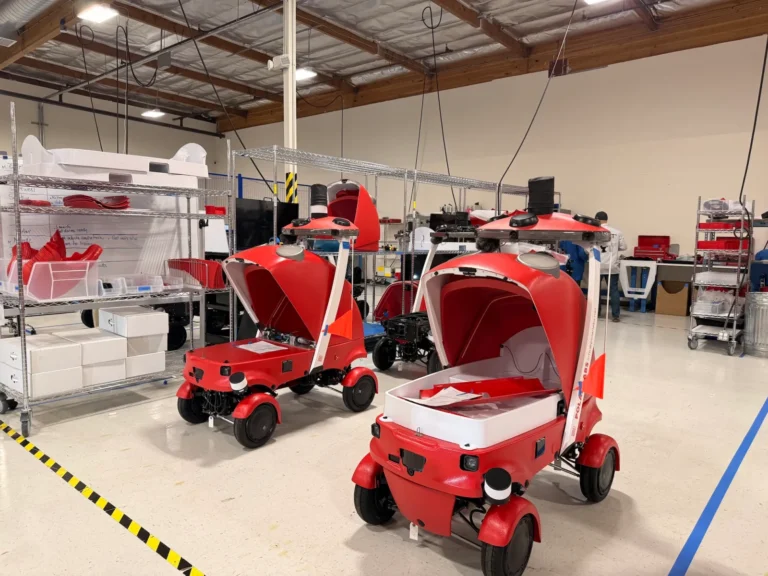After seven years in stealth, the delivery giant is scaling production of its autonomous sidewalk robots—and betting that local manufacturing will give it an edge
Inside a sprawling manufacturing facility in this Bay Area city, a assembly line of bright red robots with cartoon-like eyes represents DoorDash’s latest gamble: that the future of delivery can be built just miles from where it was designed.
The robots, called Dot, are DoorDash’s answer to a trillion-dollar question facing the gig economy—how to make local delivery economically sustainable as labor costs rise and customer expectations for speed and convenience continue to climb. At one-tenth the size of a car, these autonomous delivery vehicles navigate bike lanes, roadways, and sidewalks to complete what DoorDash has already done over a million times with human dashers.
But what makes DoorDash’s approach distinctive isn’t just the technology— it’s where and how these robots are being built.
The Fremont Advantage
DoorDash Labs, the company’s robotics and automation arm, partnered with Sonic Manufacturing to produce Dot at scale in Fremont, deliberately choosing proximity over the cost savings of overseas production. Harrison Shih, head of product for DoorDash Labs, says the decision came down tospeed and agility.
“At DoorDash, we move really, really quickly,” Shih explained during a recent media tour of the facility. “A lot of things still need to be figured out. That’s been a huge advantage to us, just being kind of down the road, essentially, to be able to build here.”
The manufacturing setup reflects a hybrid model increasingly popular among tech companies looking to maintain control during critical development phases. About 20 Sonic employees work alongside DoorDash engineers on the production floor, creating a feedback loop that allows for rapid iteration.
“Seven years of really looking at a problem, thinking about all the intricaciesof the electrical systems, is very different when you actually have to put itinto dozens and dozens of these actual builds that have to go and roam onthe street,” Shih noted.
Ken Raab, president and founder of Sonic Manufacturing, says his company’s 28 years in Fremont and experience across autonomous vehicle and robotics projects made it a natural fit. But the timeline was aggressive. “From designing the line to rolling out our first robot, [it] only took a matter of weeks,” Shih said. “In other situations, that could take many months or a year.”
Built for the Bike Lane
Each Dot takes just under a week to assemble, moving through calibration stations where engineers ensure the wheels are aligned and the autonomous systems are functioning properly. The robots can travel up to 20 miles perhour, though they slow considerably on sidewalks.
The design philosophy driving Dot’s development was simple but deliberate.
“We wanted to be approachable, cute, and friendly,” Shih said. The robots feature addressable LED eyes that can look around, blink, and wink, plus a display strip that can show a customer’s name or delivery status. For Valentine’s Day, the team programmed hearts into the display.
This focus on appearing non-threatening addresses one of the biggest challenges facing sidewalk robotics: public acceptance. “When we go in there, people love interacting with Dot. They see it out there, and it just feels like part of the community,” Shih said.
The robots communicate primarily through eye movements and behavior rather than speech—similar to how cyclists and drivers signal intentions without verbal communication. Microphones help Dot respond to its environment, particularly emergency vehicles that require it to move aside.
Phoenix First, Bay Area Next?
Dot is already operating in Phoenix through an early access program, though DoorDash only publicly announced the initiative last week. The company has been collecting data from real customer deliveries and merchant interactions to refine the system before scaling production.
“We built the autonomy kind of autonomous dispatcher, delivery platform first to make sure that we could get all that data back,” Shih explained. “We really wanted to be a part of the DoorDash Ecosystem, not just the science project.”
When asked about bringing Dot to the Bay Area—where DoorDash developed the technology—Shih was measured. “We are very excited to continue deploying Dot as we can build more and get them out there. But we’re taking a very measured approach as we kind of work with local officials and different governments.”
The company’s autonomous delivery platform integrates data from Dot alongside traditional dashers, allowing DoorDash to optimize each delivery. A recently announced “smart scale” validates orders before they’re loaded, while cargo monitoring tracks what’s inside the robot throughout the journey.
The Economics of Automation
DoorDash has taken what Shih describes as a “very scrappy, lean startup mentality” to developing Dot, accomplishing its goals “for a fraction of the cost” of comparable programs. The company’s advantage, he argues, comesfrom its intimate understanding of the delivery problem after facilitating millions of orders.
For Sonic Manufacturing, which employs just under 400 people across multiple Fremont facilities, the DoorDash partnership represents the kind of advanced manufacturing work increasingly returning to American shores— not because of labor costs, but because of the value of proximity during development.
“It’s way, way more difficult to manufacture remotely,” Shih noted. “To send your engineers out there for weeks and hotels, and they’re removed from the development. But here, the advantage is, you know, a lot of people live close by, and it’s just a commute.”
As the assembly line in Fremont continues producing Dot robots destined for Phoenix and beyond, DoorDash is betting that the “made in America”—and more specifically, “made in the Bay Area”—approach will prove faster and more flexible than the offshore manufacturing model that dominated the previous generation of consumer hardware.
Whether that bet pays off will depend not just on the technology working, but on customers, merchants, and cities embracing a future where cute red robots with blinking eyes become as commonplace on sidewalks as the delivery drivers they’re designed to complement—and potentially replace.

